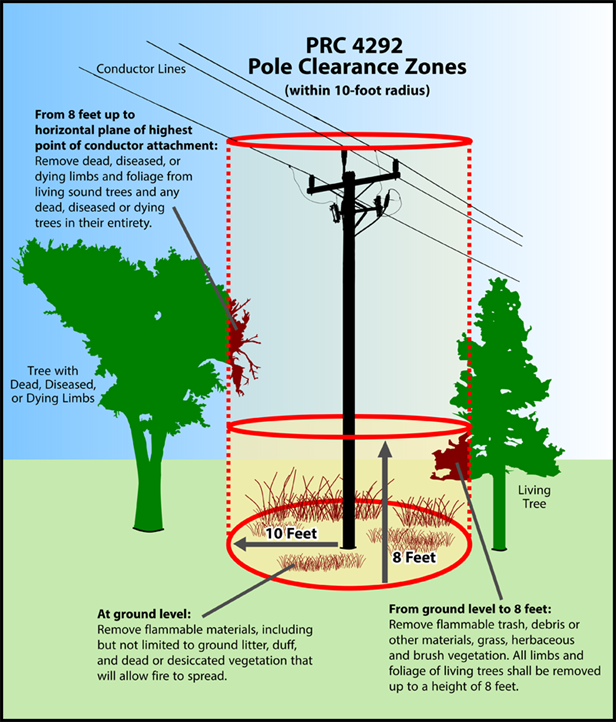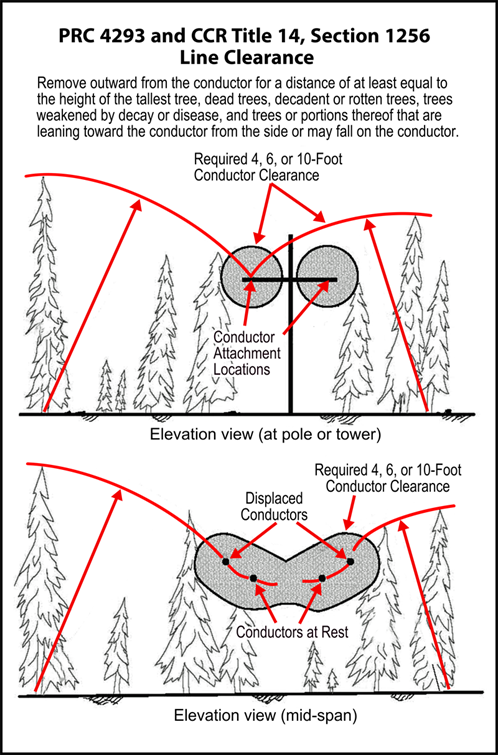Utility Wildfire Mitigation Program
Program Description
This program was created in 2018 by Senate Bills 1028 and 901 as a response to loss of property and lives from utility-caused fires and climate change. The Utility Wildfire Mitigation Program serves as a liaison between CAL FIRE and electric utilities and other state agencies. It represents CAL FIRE in various interagency efforts, including consulting in review of the annual investor-owned utility (IOU) wildfire mitigation plans (WMPs), legislation review, public safety power shutoff (PSPS) event monitoring, and assisting in the annual development of a list of qualified independent evaluators tasked with inspecting IOU assets.
This program also maintains the California Power Line Fire Prevention Field Guide (available on CAL FIRE’s Wildfire Prevention Field Guides page) and supports CAL FIRE power line inspections with training and data collection resources as part of enforcing California Public Resources Codes (PRCs) 4292 and 4293. These codes cover vegetation clearance around power lines and poles (see sections below for more details).

The IOU service territories cover the vast majority of California, but there are also numerous publicly-owned utilities (POUs) and electric cooperatives and tribal entities. Both IOUs and other utilities are required to regularly submit wildfire mitigation plans to regulators. The California Energy Commission (CEC) provides a PDF map of utility territories as well as territory GIS data.
Public Resources Codes 4292 and 4293 Clearance and Related Regulations
Except as otherwise provided in Section 4296, any person that owns, controls, operates, or maintains any electrical transmission or distribution line upon any mountainous land, or forest-covered land, brush-covered land, or grass-covered land shall, during such times and in such areas as are determined to be necessary by the director or the agency which has primary responsibility for fire protection of such areas, maintain around and adjacent to any pole or tower which supports a switch, fuse, transformer, lightning arrester, line junction, or dead end or corner pole, a firebreak which consists of a clearing of not less than 10 feet in each direction from the outer circumference of such pole or tower. This section does not, however, apply to any line which is used exclusively as telephone, telegraph, telephone or telegraph messenger call, fire or alarm line, or other line which is classed as a communication circuit by the Public Utilities Commission. The director or the agency which has primary fire protection responsibility for the protection of such areas may permit exceptions from the requirements of this section which are based upon the specific circumstances involved.
(Amended by Stats. 1976, Ch. 1300.)
- https://leginfo.legislature.ca.gov/faces/codes_displaySection.xhtml?sectionNum=4292&lawCode=PRC

Except as otherwise provided in Sections 4294 to 4296, inclusive, any person that owns, controls, operates, or maintains any electrical transmission or distribution line upon any mountainous land, or in forest-covered land, brush-covered land, or grass-covered land shall, during such times and in such areas as are determined to be necessary by the director or the agency which has primary responsibility for the fire protection of such areas, maintain a clearance of the respective distances which are specified in this section in all directions between all vegetation and all conductors which are carrying electric current:
(a) For any line which is operating at 2,400 or more volts, but less than 72,000 volts, four feet.
(b) For any line which is operating at 72,000 or more volts, but less than 110,000 volts, six feet.
(c) For any line which is operating at 110,000 or more volts, 10 feet.
In every case, such distance shall be sufficiently great to furnish the required clearance at any position of the wire, or conductor when the adjacent air temperature is 120 degrees Fahrenheit, or less. Dead trees, old decadent or rotten trees, trees weakened by decay or disease and trees or portions thereof that are leaning toward the line which may contact the line from the side or may fall on the line shall be felled, cut, or trimmed so as to remove such hazard. The director or the agency which has primary responsibility for the fire protection of such areas may permit exceptions from the requirements of this section which are based upon the specific circumstances involved.
(Amended by Stats. 1976, Ch. 1300.)
- https://leginfo.legislature.ca.gov/faces/codes_displaySection.xhtml?sectionNum=4293&lawCode=PRC

General Information
Additional Vegetation Clearance Regulations
- California Public Utilities Commission (CPUC) General Order (GO) 95
- North American Electric Reliability Corporation (NERC) Standard FAC 003-4
Power Line Fire Mitigation Resources
CAL FIRE Incidents
Other Utility Fire Mitigation Entities
- Office of Energy Infrastructure SafetyExternal Link
- California Wildfire Safety Advisory BoardExternal Link
Wildfire Mitigation Plans
- Investor-Owned Utility Wildfire Mitigation PlansExternal Link
- Publicly-Owned Utility Wildfire Mitigation PlansExternal Link
California Public Utilities Commission
- Wildfire Safety and Enforcement BranchExternal Link
- Safety and Enforcement DivisionExternal Link
- Public Safety Power Shutoff (PSPS) and De-energization InformationExternal Link
- High Fire-Threat District Map External Link
- High-Fire Threat District Tiers 2 and 3 GIS Data
- High-Fire Threat District Tier 1 GIS Data
Deputy Chief
shaun.fairbanks@fire.ca.gov
Battalion Chief
stephen.volmer@fire.ca.gov
Battalion Chief
kyle.oneil@fire.ca.gov
GIS Specialist
tristan.howard@fire.ca.gov